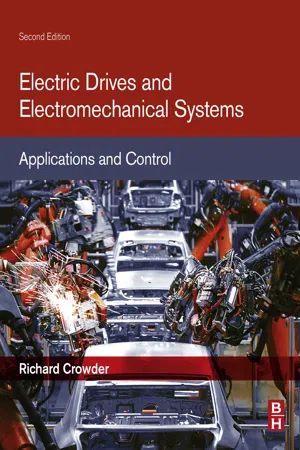
- 322 pages
- English
- ePUB (mobile friendly)
- Available on iOS & Android
About this book
Electric Drives and Electromechanical Devices: Applications and Control, Second Edition, presents a unified approach to the design and application of modern drive system. It explores problems involved in assembling complete, modern electric drive systems involving mechanical, electrical, and electronic elements. This book provides a global overview of design, specification applications, important design information, and methodologies.This new edition has been restructured to present a seamless, logical discussion on a wide range of topical problems relating to the design and specification of the complete motor-drive system. It is organised to establish immediate solutions to specific application problem. Subsidiary issues that have a considerable impact on the overall performance and reliability, including environmental protection and costs, energy efficiency, and cyber security, are also considered.- Presents a comprehensive consideration of electromechanical systems with insights into the complete drive system, including required sensors and mechanical components- Features in-depth discussion of control schemes, particularly focusing on practical operation- Includes extensive references to modern application domains and real-world case studies, such as electric vehicles- Considers the cyber aspects of drives, including networking and security
Frequently asked questions
- Essential is ideal for learners and professionals who enjoy exploring a wide range of subjects. Access the Essential Library with 800,000+ trusted titles and best-sellers across business, personal growth, and the humanities. Includes unlimited reading time and Standard Read Aloud voice.
- Complete: Perfect for advanced learners and researchers needing full, unrestricted access. Unlock 1.4M+ books across hundreds of subjects, including academic and specialized titles. The Complete Plan also includes advanced features like Premium Read Aloud and Research Assistant.
Please note we cannot support devices running on iOS 13 and Android 7 or earlier. Learn more about using the app.
Information
Electromechanical systems
Abstract
Keywords
1.1. Principles of automation
- • Fixed automation is typically employed for products with a very high production rate; the high initial cost of fixed-automation plant can therefore be spread over a very large number of units. Fixed-automation systems are used to manufacture products as diverse as cigarettes and steel nails. The significant feature of fixed automation is that the sequence of the manufacturing operations is fixed by the design of the production machinery, and therefore the sequence cannot easily be modified at a later stage of a product's life cycle.
- • Programmable automation can be considered to exist where the production equipment is designed to allow a range of similar products to be produced. The production sequence is controlled by a stored program, but to achieve a product change-over, considerable reprogramming and tooling changes will be required. In any case, the process machine is a stand-alone item, operating independently of any other machine in the factory; this principle of automation can be found in most manufacturing processes and it leads to islands of automation. The concept of programmable automation has its roots in the Jacquard looms of the nineteenth century, where weaving patterns were stored on a punched-card system.
- • Flexible automation is an enhancement of programmable automation in which a computer-based manufacturing system has the capability to change the manufacturing program and the physical configuration of the machine tool or cell with a minimal loss in production time. In many systems the machining programs are prepared at a location remote from the machine, and they are then transmitted as required over a computer-based local-area communication network.
Table of contents
- Cover image
- Title page
- Table of Contents
- Copyright
- Preface
- List of principal symbols
- 1. Electromechanical systems
- 2. Analysing a drive system
- 3. Power transmission and sizing
- 4. Velocity and position transducers
- 5. Brushed direct-current motors
- 6. Brushless motors
- 7. Induction motors
- 8. Stepper motors
- 9. Related motors and actuators
- 10. Controllers for automation
- 11. Cyber Physical systems and security
- Appendix 1: Units and conversion factors
- Index